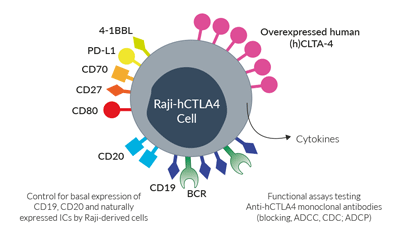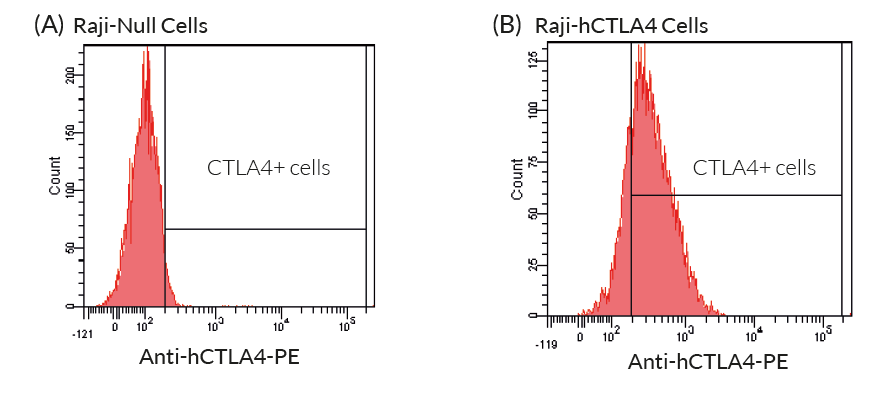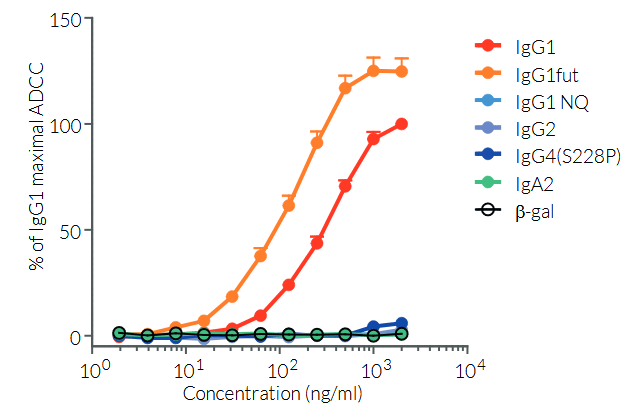Human CTLA4-expressing Raji Cells
| Product | Unit size | Cat. code | Docs. | Qty. | Price | |
|---|---|---|---|---|---|---|
|
Raji-hCTLA4 Cells Human lymphoblast cells - ADCC CTLA-4 Target Cells |
Show product |
3-7 x 10e6 cells |
raji-hctla4
|
|
||
|
Raji-hCTLA4 vial Additional cell vial |
Show product |
3-7 x 10e6 cells |
raji-hctla4-av
|
Notification: Reference #raji-hctla4-av can only be ordered together with reference #raji-hctla4.
Human CTLA-4-expressing B cells
Raji-hCTLA4 cells were developed from the Raji cell line, a human B lymphocyte-derived cell line. Raji cells have been successfully used as target cells in CAR-T toxicity assays as well as in human effector studies such as antibody-dependent cellular cytotoxicity (ADCC), either with peripheral blood mononuclear cells, natural killer (NK) cells, or T cell-derived Jurkat reporter cells.
CTLA-4 (cytotoxic T cell lymphocyte antigen-4; also known as CD152) is a type I transmembrane protein expressed at the cell surface of activated conventional T cells and constitutively on immunosuppressive regulatory T cells (Tregs). CTLA-4 is an inhibitory immune checkpoint that prevents T-cell overstimulation and host damage. It exerts competitive binding for stimulatory CD28 ligands (CD80/CD86) [1].
Features of Raji-hCTLA4 cells:

Surface expressed markers and ICs in Raji-hCTLA4 cells
- Stable overexpression of the human CTLA-4 gene
- Characterized by a number of cell-surface expressed markers including the B cell receptor (BCR), CD19, and CD20
- Constitutive expression of various immune checkpoints (ICs) such as CD27, CD70, CD80, PD-L1, and 4-1BBL
- The stability for 20 passages following thawing has been verified
Applications for Raji-hCTLA4 cells:
- Target cell line for ADCC assays using InvivoGen's Jurkat-Lucia™ NFAT-CD16 cells
- Target cell line for cell toxicity assays using NK or CAR-T cells
- For use in the development of other functional assays
Validation of Raji-hCTLA4 cells:
- Overexpression of CTLA-4 verified by flow cytometry
- Functionally tested as target cells in ADCC assays using anti-human CTLA-4 monoclonal Abs and Jurkat-Lucia™ NFAT-CD16 cells
- Guaranteed mycoplasma-free
References:
1. Ribas A. and Wolchock J.D., 2018. Cancer immunotherapy using checkpoint blockade. Science. 359:1350-55.
Back to the topSpecifications
Antibiotic resistance: Blasticidin
Growth medium: IMDM, 2 mM L-glutamine, 25 mM HEPES, 10% heat-inactivated fetal bovine serum (FBS; 30 min at 56 °C), 10 μg/ml Blasticidin, Pen-Strep (100 U/ml-100 µg/ml)
Test medium: IMDM, 2 mM L-glutamine, 25 mM HEPES, 10% heat-inactivated FBS, Pen-Strep (100 U/ml-100 µg/ml)
Quality control:
- Human CTLA-4 expression has been verified by flow-cytometry.
- Induction of antibody-dependent cellular cytotoxicity (ADCC) has been validated using InvivoGen’s anti-hCTLA4-hIgG1 antibody and Jurkat-NFAT Lucia™ CD16 reporter cell line.
- The stability for 20 passages following thawing has been verified.
- Raji-hCTLA4 cells are guaranteed mycoplasma-free.
Contents
- 3-7 x 106 Raji-hCTLA4 cells in a cryovial or shipping flask.
- 1 ml of Blasticidin (10 mg/ml). Store at 4 °C or at -20 °C.
- 1 ml of Normocin™ (50 mg/ml). Normocin™ is a formulation of three antibiotics active against mycoplasmas, bacteria and fungi. Store at -20 °C.
![]() Shipped on dry ice (Europe, USA & Canada)
Shipped on dry ice (Europe, USA & Canada)








